The career of German stage and film actress Margarete Schön (1895-1985) spanned nearly fifty years. She is best known for her role as Kriemhild, the beautiful but revengeful princess of Burgundy in Fritz Lang’s silent epic Die Nibelungen (1924).

German postcard by Verlag Herm. Leiser, Berlin-Wilm., no. 4838. Photo: Atelier E. Bieber, Berlin.

German postcard by Ross Verlag, no. 672/6, 1919-1924. Photo: Decla-Ufa-Film. Publicity still for Die Nibelungen (Fritz Lang, 1924).

German postcard by Ross Verlag, no. 676/1, 1919-1924. Photo: Decla-Ufa-Film. Publicity still for Die Nibelungen (Fritz Lang, 1924).
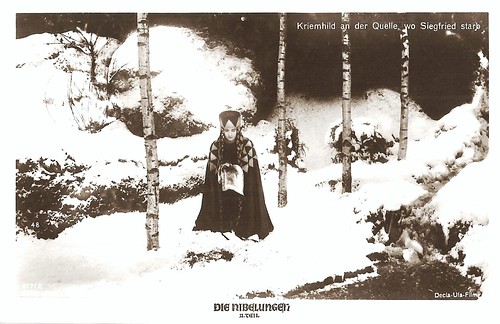
German postcard by Ross Verlag, Berlin, no. 677/2. Photo: Decla-Ufa-Film. Publicity still for Die Nibelungen, II. Teil, Kriemhilds Rache/Kriemhild's Revenge (Fritz Lang, 1924). Kriemhild (Margarete Schön) at the spring where Siegfried died.

German postcard by Ross Verlag, no. 700/10. Photo: Ufa. Publicity still for Kampf um die Scholle/Struggle for the Soil (Erich Waschneck, 1925) with Margarete Schön as Frieda, wife of Axel.
Margarete Schön was born as Margarete Schippang in Magdeburg, Germany in 1895.
She received private acting lessons with the theatre actor Hans Calm in Dessau. In 1912 she made her stage debut in Bad Freienwalde. Shortly thereafter, she received a commitment at the municipal theatre of Bromberg (now Bydgoszcz, Poland). From 1915 to 1918, she was part of the ensemble cast of the Deutsches Theater in Hannover, and from 1918 to 1945 she performed at the famous Staatstheater Berlin (Berlin State Theatre).
According to Wikipedia, Schön made her film debut in the silent Du meine Himmelskönigin/You are my queen of heaven (Carl Wilhelm, 1919). Philippe Pelletier at Ciné Artistes and Thomas Staedeli at Cyranos write that her first appearance was a year earlier, in Schirokko/Scirocco (Edmund Heuberger, 1918) with Kurt Brenkendorf.
She would spend the next years in small roles for directors Carl Froelich, Hanna Henning, and Walter Schmidthässler. She had bigger parts in Die Pflicht zu leben/The obligation to live (Carl Wilhelm, 1919) with Reinhold Schünzel, and Die goldene Krone/The Golden Crown (Alfred Halm, 1920) starring Henny Porten.
She worked several times with the Danish director Robert Dinesen who was her husband at the time. Among their films were Frauen vom Gnadenstein/Women of Gnadenstein (Joe May, Robert Dinesen, 1920), and Der Leidensweg der Inge Krafft/Inge Krafft's Calvary (Robert Dinesen, 1921) featuring Mia May.
Schön had a leading role as Hannele’s (Margarete Schlegel) mother in the popular drama Hanneles Himmelfahrt/Hannele's Ascension (Urban Gad, 1922), based on the Traumgedicht (dream poem) by Gerhart Hauptman. For director Friedrich Zelnik she appeared in Erniedrigte und beleidigte (1922) starring Lya Mara.
Then she really became a star after the release of Fritz Lang's two-part mythical fantasy Die Nibelungen (1924). Lang and his wife at the time, Thea von Harbou, had written a script based on the epic poem 'Nibelungenlied' written around AD 1200. Schön had a starring role as the vengeful Kriemhild, opposite Paul Richter as the epic hero Siegfried.
The success of Die Nibelungen (1924) would cement her popularity in Germany and she achieved international recognition as an actress. Strangely, there was not a real follow-up film. She appeared in several unremarkable productions. In the more interesting films, like her husband’s Der Weg durch die Nacht/The Way Through the Night (Robert Dinesen, 1929), she only had a supporting part.

German postcard by Ross Verlag, no. 673/1. Photo: Decla-Ufa-Film. Publicity still for Siegfried (Paul Richter) and Kriemhild (Margarete Schön) in part I. of Die Nibelungen (Fritz Lang, 1924).

German postcard by Ross Verlag, no. 700/8. Photo: Ufa. Publicity still for Kampf um die Scholle/Struggle for the Soil (Erich Waschneck, 1925) with Ferdinand von Alten and Margarete Schön.
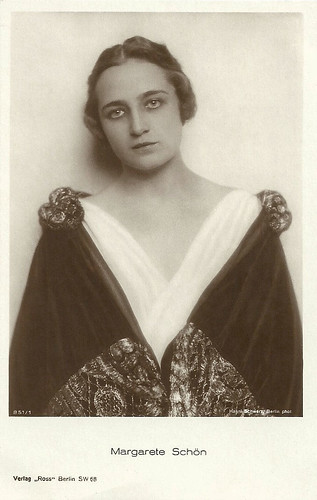
German postcard by Ross Verlag, no. 851/1, 1925-1926. Photo: Hanni Schwarze, Berlin.

German postcard by Ross Verlag, no. 1097/1, 1927-1928. Photo: Ernst Sandau, Berlin.

German postcard by Ross Verlag, no. 1922/1, 1927-1928. Photo: Atelier Ebert, Berlin.

German postcard by Ross Verlag, no. 125/6. Photo: Ufa. Otto Gebühr as Frederick the Great, Margarete Schön and Olga Engl in Das Flötenkonzert von Sanssouci/The Flute Concert of Sans-Souci (Gustav Ucicky, 1930). This picture is a literal citation of the famous painting Flötenkonzert Friedrichs des Großen in Sanssouci (1850-52) by Adolph (von) Menzel, now at the Alte Nationalgalerie in Berlin.
Margarete Schön made the transition to sound films with ease and through the 1930s and 1940s she was a popular character actress. She often portrayed parts as the wife or the mother.
For the Ufa she played princess Amalie in Das Flötenkonzert von Sans-Souci/The Flute Concert of Sans-Souci (Gustav Ucicky, 1930) starring Otto Gebühr as King Frederick II of Prussia; Madame Mercier in the Chopin biography Abschiedswalzer/Farewell Waltz (Géza von Bolváry, 1934), and the mother of Ilse Werner in Ihr erstes Erlebnis/Her First Experience (Joseph von Báky, 1939).
In 1931 she even co-directed a film herself, Schön ist die Manöverzeit/Manoeuver Time Is Fine (Margarete Schön, Erich Schönfelder, 1931) with Ida Wüst. It would remain her only directorial job.
During the Second World War she appeared in approximately ten films, but she generally avoided roles in Nazi propaganda films and stayed decidedly apolitical. One exception was an uncredited bit part in Veit Harlan's nationalistic film Kolberg (Veit Harlan, 1945) starring Heinrich George.
One of her most popular roles of the era was the character Frau Knauer opposite Heinz Rühmann in the classic comedy Die Feuerzangenbowle/The Punch Bowl (Helmut Weiss, 1944) for the Terra-Filmkunst studios.
After the Second World War, Schön worked extensively for the radio and also worked as a voice actor for the synchronisation of foreign films.
From 1948 to 1950, she played for the Deutsche Film-Aktiengesellschaft (DEFA), the state-owned film studio of East Germany. There she appeared in small roles in such films as Affaire Blum/The Blum Affair (Erich Engel, 1948) about an anti-Semitic court case in Weimar Germany, Die blauen Schwerter/The Blue Swords (Wolfgang Schleif, 1949) starring Hans Quest as the inventor of blue porcelain, and the biography Semmelweis - Retter der Mütter/Dr. Semmelweis (Georg C. Klaren, 1950) with Käthe Braun.
In West-Germany she had parts in such films as the thriller Rittmeister Wronski/Cavalry Captain Wronski (Ulrich Erfurth, 1954) starring Willi Birgel, and Oberwachtmeister Borck/Sergeant Borck (Gerhard Lamprecht, 1955). Her last screen appearance was in the TV film Ich rufe Dresden/I Call Dresden (Curt Goetz-Pflug, 1960).
That same year Margarete Schön retired from acting. In 1968, she was awarded the Bundesfilmpreis for her long and outstanding achievements in the German cinema. At the age of 90, she died in West-Berlin, Germany in 1985. Schön was married to Danish director Robert Dinesen.
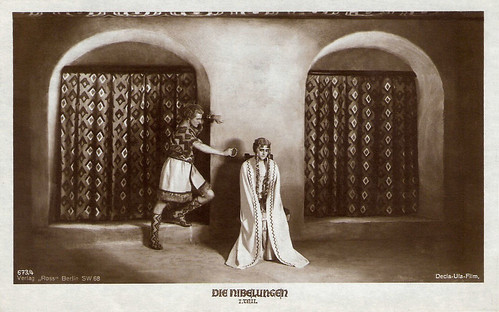
German postcard by Ross Verlag, Berlin, no. 673/4, 1919-1924. Photo: Decla-Ufa-Film. Publicity still for Die Nibelungen: Siegfried (Fritz Lang, 1924). Caption: Siegfried (Paul Richter) presents Kriemhild (Margarete Schön) the circlet.
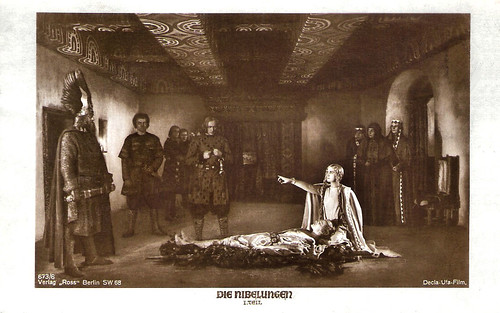
German postcard by Ross Verlag, Berlin, nr. 673/6, ca. 1924. Photo: Decla-Ufa-Film. Publicity still for Die Nibelungen: Siegfried (Fritz Lang, 1924). Kriemhild (Margarete Schön) mourns Siegfried's (Paul Richter) death and points accusingly to Volker von Alzey (Hans Adalbert Schlettow).
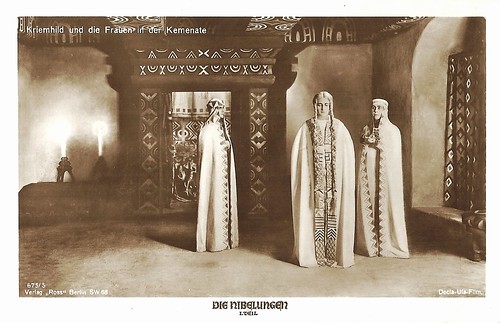
German postcard by Ross Verlag, Berlin, no. 675/5. Photo: Decla-Ufa-Film. Publicity still for Die Nibelungen, part I, Siegfried (Fritz Lang, 1924). Kriemhild (Margarete Schön) and the women in the 'kemenate', the heated private room of the castle, also called 'cabinet'.

German postcard by Ross Verlag, Berlin, no. 675/9, 1919-1924. Photo: Decla-Ufa-Film. Publicity still for Die Nibelungen: Siegfried (Fritz Lang, 1924). Kriemhild (Margarete Schön) and Brunhild (Hanna Ralph) at the side of the body of Siegfried (Paul Richter).
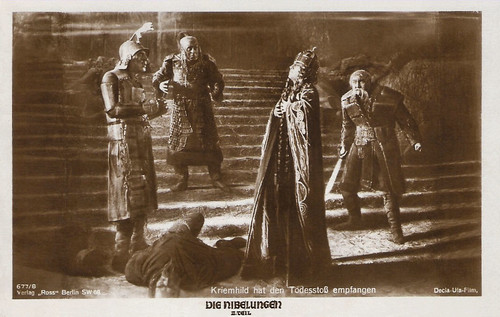
German postcard by Ross Verlag, Berlin, no. 677/8, 1919-1924. Photo: Decla-Ufa-Film. Publicity still for Die Nibelungen 2: Kriemhilds Rache/Die Nibelungen: Kriemhild's Revenge (Fritz Lang, 1924). Kriemhild (Margarete Schön) has got the deathblow. In the back, King Hetzel (Rudolf Klein-Rogge) looks on in astonishment.
Sources: Philippe Pelletier (CinéArtistes - French), Volker Wachter (DEFA Filmsterne - German), Thomas Staedeli (Cyranos), Wikipedia and IMDb.

German postcard by Verlag Herm. Leiser, Berlin-Wilm., no. 4838. Photo: Atelier E. Bieber, Berlin.

German postcard by Ross Verlag, no. 672/6, 1919-1924. Photo: Decla-Ufa-Film. Publicity still for Die Nibelungen (Fritz Lang, 1924).

German postcard by Ross Verlag, no. 676/1, 1919-1924. Photo: Decla-Ufa-Film. Publicity still for Die Nibelungen (Fritz Lang, 1924).

German postcard by Ross Verlag, Berlin, no. 677/2. Photo: Decla-Ufa-Film. Publicity still for Die Nibelungen, II. Teil, Kriemhilds Rache/Kriemhild's Revenge (Fritz Lang, 1924). Kriemhild (Margarete Schön) at the spring where Siegfried died.

German postcard by Ross Verlag, no. 700/10. Photo: Ufa. Publicity still for Kampf um die Scholle/Struggle for the Soil (Erich Waschneck, 1925) with Margarete Schön as Frieda, wife of Axel.
The Vengeful Kriemhild
Margarete Schön was born as Margarete Schippang in Magdeburg, Germany in 1895.
She received private acting lessons with the theatre actor Hans Calm in Dessau. In 1912 she made her stage debut in Bad Freienwalde. Shortly thereafter, she received a commitment at the municipal theatre of Bromberg (now Bydgoszcz, Poland). From 1915 to 1918, she was part of the ensemble cast of the Deutsches Theater in Hannover, and from 1918 to 1945 she performed at the famous Staatstheater Berlin (Berlin State Theatre).
According to Wikipedia, Schön made her film debut in the silent Du meine Himmelskönigin/You are my queen of heaven (Carl Wilhelm, 1919). Philippe Pelletier at Ciné Artistes and Thomas Staedeli at Cyranos write that her first appearance was a year earlier, in Schirokko/Scirocco (Edmund Heuberger, 1918) with Kurt Brenkendorf.
She would spend the next years in small roles for directors Carl Froelich, Hanna Henning, and Walter Schmidthässler. She had bigger parts in Die Pflicht zu leben/The obligation to live (Carl Wilhelm, 1919) with Reinhold Schünzel, and Die goldene Krone/The Golden Crown (Alfred Halm, 1920) starring Henny Porten.
She worked several times with the Danish director Robert Dinesen who was her husband at the time. Among their films were Frauen vom Gnadenstein/Women of Gnadenstein (Joe May, Robert Dinesen, 1920), and Der Leidensweg der Inge Krafft/Inge Krafft's Calvary (Robert Dinesen, 1921) featuring Mia May.
Schön had a leading role as Hannele’s (Margarete Schlegel) mother in the popular drama Hanneles Himmelfahrt/Hannele's Ascension (Urban Gad, 1922), based on the Traumgedicht (dream poem) by Gerhart Hauptman. For director Friedrich Zelnik she appeared in Erniedrigte und beleidigte (1922) starring Lya Mara.
Then she really became a star after the release of Fritz Lang's two-part mythical fantasy Die Nibelungen (1924). Lang and his wife at the time, Thea von Harbou, had written a script based on the epic poem 'Nibelungenlied' written around AD 1200. Schön had a starring role as the vengeful Kriemhild, opposite Paul Richter as the epic hero Siegfried.
The success of Die Nibelungen (1924) would cement her popularity in Germany and she achieved international recognition as an actress. Strangely, there was not a real follow-up film. She appeared in several unremarkable productions. In the more interesting films, like her husband’s Der Weg durch die Nacht/The Way Through the Night (Robert Dinesen, 1929), she only had a supporting part.

German postcard by Ross Verlag, no. 673/1. Photo: Decla-Ufa-Film. Publicity still for Siegfried (Paul Richter) and Kriemhild (Margarete Schön) in part I. of Die Nibelungen (Fritz Lang, 1924).

German postcard by Ross Verlag, no. 700/8. Photo: Ufa. Publicity still for Kampf um die Scholle/Struggle for the Soil (Erich Waschneck, 1925) with Ferdinand von Alten and Margarete Schön.

German postcard by Ross Verlag, no. 851/1, 1925-1926. Photo: Hanni Schwarze, Berlin.

German postcard by Ross Verlag, no. 1097/1, 1927-1928. Photo: Ernst Sandau, Berlin.

German postcard by Ross Verlag, no. 1922/1, 1927-1928. Photo: Atelier Ebert, Berlin.

German postcard by Ross Verlag, no. 125/6. Photo: Ufa. Otto Gebühr as Frederick the Great, Margarete Schön and Olga Engl in Das Flötenkonzert von Sanssouci/The Flute Concert of Sans-Souci (Gustav Ucicky, 1930). This picture is a literal citation of the famous painting Flötenkonzert Friedrichs des Großen in Sanssouci (1850-52) by Adolph (von) Menzel, now at the Alte Nationalgalerie in Berlin.
Wife or Mother
Margarete Schön made the transition to sound films with ease and through the 1930s and 1940s she was a popular character actress. She often portrayed parts as the wife or the mother.
For the Ufa she played princess Amalie in Das Flötenkonzert von Sans-Souci/The Flute Concert of Sans-Souci (Gustav Ucicky, 1930) starring Otto Gebühr as King Frederick II of Prussia; Madame Mercier in the Chopin biography Abschiedswalzer/Farewell Waltz (Géza von Bolváry, 1934), and the mother of Ilse Werner in Ihr erstes Erlebnis/Her First Experience (Joseph von Báky, 1939).
In 1931 she even co-directed a film herself, Schön ist die Manöverzeit/Manoeuver Time Is Fine (Margarete Schön, Erich Schönfelder, 1931) with Ida Wüst. It would remain her only directorial job.
During the Second World War she appeared in approximately ten films, but she generally avoided roles in Nazi propaganda films and stayed decidedly apolitical. One exception was an uncredited bit part in Veit Harlan's nationalistic film Kolberg (Veit Harlan, 1945) starring Heinrich George.
One of her most popular roles of the era was the character Frau Knauer opposite Heinz Rühmann in the classic comedy Die Feuerzangenbowle/The Punch Bowl (Helmut Weiss, 1944) for the Terra-Filmkunst studios.
After the Second World War, Schön worked extensively for the radio and also worked as a voice actor for the synchronisation of foreign films.
From 1948 to 1950, she played for the Deutsche Film-Aktiengesellschaft (DEFA), the state-owned film studio of East Germany. There she appeared in small roles in such films as Affaire Blum/The Blum Affair (Erich Engel, 1948) about an anti-Semitic court case in Weimar Germany, Die blauen Schwerter/The Blue Swords (Wolfgang Schleif, 1949) starring Hans Quest as the inventor of blue porcelain, and the biography Semmelweis - Retter der Mütter/Dr. Semmelweis (Georg C. Klaren, 1950) with Käthe Braun.
In West-Germany she had parts in such films as the thriller Rittmeister Wronski/Cavalry Captain Wronski (Ulrich Erfurth, 1954) starring Willi Birgel, and Oberwachtmeister Borck/Sergeant Borck (Gerhard Lamprecht, 1955). Her last screen appearance was in the TV film Ich rufe Dresden/I Call Dresden (Curt Goetz-Pflug, 1960).
That same year Margarete Schön retired from acting. In 1968, she was awarded the Bundesfilmpreis for her long and outstanding achievements in the German cinema. At the age of 90, she died in West-Berlin, Germany in 1985. Schön was married to Danish director Robert Dinesen.

German postcard by Ross Verlag, Berlin, no. 673/4, 1919-1924. Photo: Decla-Ufa-Film. Publicity still for Die Nibelungen: Siegfried (Fritz Lang, 1924). Caption: Siegfried (Paul Richter) presents Kriemhild (Margarete Schön) the circlet.

German postcard by Ross Verlag, Berlin, nr. 673/6, ca. 1924. Photo: Decla-Ufa-Film. Publicity still for Die Nibelungen: Siegfried (Fritz Lang, 1924). Kriemhild (Margarete Schön) mourns Siegfried's (Paul Richter) death and points accusingly to Volker von Alzey (Hans Adalbert Schlettow).

German postcard by Ross Verlag, Berlin, no. 675/5. Photo: Decla-Ufa-Film. Publicity still for Die Nibelungen, part I, Siegfried (Fritz Lang, 1924). Kriemhild (Margarete Schön) and the women in the 'kemenate', the heated private room of the castle, also called 'cabinet'.

German postcard by Ross Verlag, Berlin, no. 675/9, 1919-1924. Photo: Decla-Ufa-Film. Publicity still for Die Nibelungen: Siegfried (Fritz Lang, 1924). Kriemhild (Margarete Schön) and Brunhild (Hanna Ralph) at the side of the body of Siegfried (Paul Richter).

German postcard by Ross Verlag, Berlin, no. 677/8, 1919-1924. Photo: Decla-Ufa-Film. Publicity still for Die Nibelungen 2: Kriemhilds Rache/Die Nibelungen: Kriemhild's Revenge (Fritz Lang, 1924). Kriemhild (Margarete Schön) has got the deathblow. In the back, King Hetzel (Rudolf Klein-Rogge) looks on in astonishment.
Sources: Philippe Pelletier (CinéArtistes - French), Volker Wachter (DEFA Filmsterne - German), Thomas Staedeli (Cyranos), Wikipedia and IMDb.
3 comments:
Parabéns por tão excelente blog.Grande abraço.
Obrigado e um abraço de volta a partir de Amesterdão.
Obrigada por seu blog, sua publicação, tenho o mesmo nome da atriz: Margaret Schön, fiquei muito feliz ao saber sobre isso!
Post a Comment